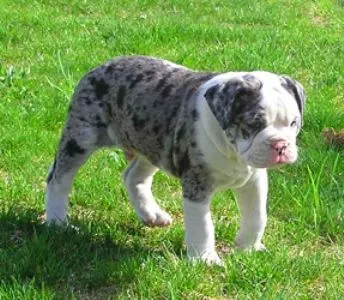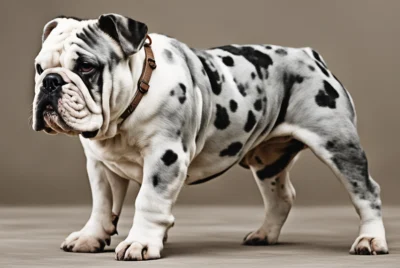Blue Merle English Bulldog: Their History, Care, and Temperament
Owning a Blue Merle English Bulldog can be a rewarding experience, but it also comes with challenges. From understanding their unique history to meeting their specific care requirements and navigating their distinct temperament, there’s a lot to learn when it comes to caring for these captivating canines.
In this comprehensive guide, we’ll unravel the mysteries behind these beloved companions, offering insights into their fascinating history, essential care tips, and endearing temperament.
What Is a Blue Merle English Bulldog?
A Blue Merle English Bulldog is a distinct variation of the English Bulldog breed characterized by its striking coat coloration. The term “blue merle” refers to a marbled or mottled pattern of blue, grey, and occasionally white or brown patches on the dog’s coat.
This unique coloring results from the presence of the Merle gene, which creates the captivating visual effect seen in Blue Merle Bulldogs. While they share the same physical characteristics and temperament as standard English Bulldogs, Blue Merle Bulldogs stand out for their eye-catching coat pattern.
However, it’s important to note that Blue Merle Bulldogs may be associated with certain health considerations due to the genetics behind their coat coloration. Despite these potential challenges, Blue Merle English Bulldogs remain beloved companions cherished for their unique appearance and affectionate nature.
Physical Characteristics of Blue Merle English Bulldog
Size and Weight
The Blue Merle English Bulldog is a medium-sized breed, typically measuring between 16 to 20 inches in height and weighing around 40 to 60 pounds.
Despite its compact stature, this Bulldog exudes strength and muscularity, reflecting its historical role as a tenacious working dog.
Coat Color and Pattern
One of the most striking features of the Blue Merle English Bulldog is its coat color and pattern. The term “blue merle” refers to a marbled or mottled coat pattern characterized by shades of blue, grey, and occasionally white or brown patches.
This unique coloration is a result of the Merle gene, which creates a mesmerizing tapestry of hues across the dog’s fur.
Facial Features and Body Structure
The facial features of the Blue Merle English Bulldog are as distinctive as they are endearing. With its broad muzzle, pronounced underbite, and round, expressive eyes, this breed possesses a charming and iconic visage that melts hearts wherever it goes.
Coupled with its characteristic wrinkles and folds, the Bulldog’s face exudes character and charm. Regarding body structure, the Blue Merle Bulldog maintains the muscular build and sturdy stance synonymous with the breed.
Unique Traits of the Blue Merle Variation
Beyond its visually striking appearance, the Blue Merle English Bulldog possesses unique traits that set it apart from other Bulldogs.
The Merle gene responsible for its distinctive coat coloration can also be associated with certain health considerations, including a heightened risk of hereditary issues such as deafness, vision problems, and skin disorders.
Read also: Owning Merle Bulldogs: A Guide to Genetics, Health, and Responsible Ownership

Temperament and Behavior of Blue Merle English Bulldog
General Temperament of English Bulldogs
English Bulldogs, including the Blue Merle variety, are renowned for their gentle and affectionate nature. They are often described as loyal, easygoing, and affectionate bulldogs that form strong bonds with their families. Despite their muscular appearance, Bulldogs are typically calm and low-energy, preferring to lounge around rather than engage in vigorous physical activities.
Influence of Genetics on Behavior
Genetics plays a big role in shaping the behavior of Blue Merle English Bulldogs. While their temperament is influenced by their breeding and upbringing, certain genetic factors, such as the merle gene responsible for their coat coloration, may also impact their behavior. Breeders must prioritize temperament and health when selecting breeding pairs to ensure puppies inherit desirable behavioral traits.
Socialization and Training Considerations
Proper socialization and training are crucial for Blue Merle English Bulldogs to develop well-adjusted behavior. Early socialization exposes them to various animals, people, and outside environments, helping them become confident and adaptable adults.
Positive reinforcement-based training methods work best for Bulldogs, as they respond well to praise and rewards. Consistent training helps instill good manners and prevents behavioral issues later in life.
Potential Health Concerns and Their Impact on Behavior
Like all dog breeds, Blue Merle English Bulldogs may be predisposed to certain health concerns that can influence their behavior.
For example, Bulldogs are prone to brachycephalic obstructive airway syndrome (BOAS) due to their flat faces, which can affect their breathing and activity levels.
Additionally, genetic issues associated with the Merle gene, such as deafness or vision problems, may impact a Bulldog’s behavior and quality of life.
Read also: 10 Things They Don’t Tell You About Merle English Bulldogs

Care and Maintenance of Blue Merle English Bulldog
Diet and Nutrition Requirements
Provide your Blue Merle English Bulldog with a balanced diet that meets their nutritional needs. Choose high-quality dog food formulated for Bulldogs, considering their age, size, and activity level.
Avoid overfeeding to prevent obesity, a common issue in the breed. Always givefresh water and monitor their food intake to maintain a healthy weight.
Exercise Needs and Activity Level
While Blue Merle Bulldogs have a moderate activity level, they still require daily exercise to stay healthy and prevent weight gain. Take them for short walks or play sessions to stimulate their minds and bodies.
Avoid strenuous activities, especially in hot weather, due to their brachycephalic (flat-faced) anatomy, which can make breathing difficult.
Grooming Tips for Maintaining the Coat
The Blue Merle Bulldog’s coat may require regular grooming to keep it clean and healthy. Brush their coat weekly to remove loose dog hair and prevent matting. I recommend using a soft-bristled brush or grooming mitt to avoid irritating their sensitive skin.
Pay special attention to their wrinkles and folds, keeping them clean and dry to prevent skin infections. Bathe your Bulldog using a gentle dog shampoo recommended by your veterinarian.
Health Care Considerations Specific to the Breed
Blue Merle English Bulldogs are prone to certain health issues that require special attention. Regular veterinary check-ups are important to monitor their overall health and promptly address concerns.
Due to their brachycephalic anatomy, Bulldogs may experience breathing difficulties and overheating, especially in hot weather. Keep them cool and provide access to shade and fresh water.
Additionally, be aware of genetic issues associated with the Merle gene, such as deafness or vision problems, and discuss preventive measures with your veterinarian.
Does Akc Recognize Blue Merle English Bulldogs?
The American Kennel Club (AKC) does not recognize the Blue Merle color pattern in English Bulldogs. This is primarily due to concerns about associated health risks, as the Merle gene linked to the Blue Merle coat pattern can also increase the likelihood of certain hereditary health issues.
As a result, Blue Merle English Bulldogs cannot be registered with the AKC, and they are not eligible to participate in AKC-sanctioned events or competitions.
Feeding Blue Merle English Bulldog Puppy
When feeding a Blue Merle English Bulldog puppy, giving a balanced and nutritious diet tailored to their age, size, and activity level is crucial.
Choose high-quality puppy food specifically formulated for Bulldogs to support their growth and development. I recommend feeding them small, frequent meals throughout the day to accommodate their small stomachs and prevent digestive issues.
Avoid overfeeding and monitor their weight to prevent obesity, which can contribute to health problems later in life. Additionally, provide plenty of fresh water to keep them hydrated.
Price of Blue Merle English Bulldog
The price of a Blue Merle English Bulldog can differ depending on factors such as pedigree, lineage, breeder reputation, and demand for the color variation. Generally, Blue Merle Bulldogs tend to be more expensive than their standard-colored counterparts due to their rarity and unique appearance.
Prices for Blue Merle English Bulldogs can range from several thousand dollars to tens of thousands of dollars, with some individuals fetching particularly high prices in the market.
Conclusion
Blue Merle English Bulldogs are captivating canine companions with a rich history and endearing temperament. Owners can ensure that these beloved Bulldogs thrive and flourish as cherished family members by providing them with proper care, including nutrition, exercise, grooming, and healthcare.
With their unique appearance and gentle demeanor, Blue Merle Bulldogs continue to capture the hearts of dog lovers worldwide.




